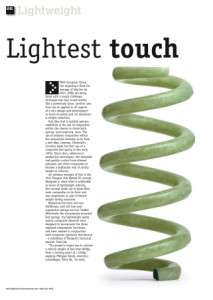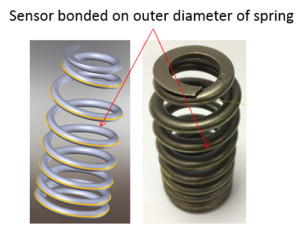Validating composite spring designs with high definition fiber optic sensing (HD-FOS)
July 2015 Vehicle Dynamics International Magazine – presents a case study using composites in automotive suspension design
 In the July 2015 issue of Vehicle Dynamics International magazine, the author of the article ‘Lightest Touch’ asks if using composites within an automotive chassis is the key to achieving EU and US mileage targets. The article presents a case study of a light weighting program for the 2013 Peugeot 208 Hybrid FE, targeting a 20% reduction in vehicle weight. Peugeot achieved this goal in large part by focusing on substituting glass fiber resin composite materials for the steel used in the vehicle’s suspension systems. The suspension/chassis components represent a substantial percentage of vehicle weight exceeded only by the powertrain and body. Furthermore, the fabrication of suspension components from composite materials more easily align with the current state of composite manufacturing processes. Within the automotive industry, suspension systems and other chassis components may represent the low hanging fruit for the early adopters of composites.
In the July 2015 issue of Vehicle Dynamics International magazine, the author of the article ‘Lightest Touch’ asks if using composites within an automotive chassis is the key to achieving EU and US mileage targets. The article presents a case study of a light weighting program for the 2013 Peugeot 208 Hybrid FE, targeting a 20% reduction in vehicle weight. Peugeot achieved this goal in large part by focusing on substituting glass fiber resin composite materials for the steel used in the vehicle’s suspension systems. The suspension/chassis components represent a substantial percentage of vehicle weight exceeded only by the powertrain and body. Furthermore, the fabrication of suspension components from composite materials more easily align with the current state of composite manufacturing processes. Within the automotive industry, suspension systems and other chassis components may represent the low hanging fruit for the early adopters of composites.
Transitioning from traditional metals to composites – challenges and unknowns
Composite materials have gained significant traction in both the military and commercial aerospace sectors, owing to their ability to offer a high strength-to-weight ratio. The introduction of composites in aerospace has not been problem-free however, and in many respects the aerospace industry remains on a learning curve. Designers in the automotive industry need to be aware that the anisotropic and heterogeneous characteristics of composites limit the availability of published material property data. Without this data, engineers can no longer be certain that computer aided engineering (CAE) and other simulation tools will provide accurate predictions of component performance. Composite materials offer additional challenges in manufacturing and engineers need to ensure that part-to-part variability is well understood and under control. Within the aerospace industry the challenges posed by the use of composites is addressed, in part, by adopting new technologies in the test and validation methods used for composite structures. High definition fiber optic sensing (HD-FOS) from Luna is a key test and validation technology used at all levels of the aerospace value chain.
Instrumenting a composite part with HD-FOS – achieving a full field view of strain impossible with strain gages
Strain gages are the traditional method of measuring strain on springs. This method of point sensing is very limiting as there are only so many strain gages that can be mounted to a spring. Each strain gage needs to be individually wired and provides just a single strain measurement for every location instrumented. By contrast a single HD-FOS sensor can be mounted along the entire length of a spring and provides strain measurements in increments of one millimeter. This method of measuring strain of springs offers simplicity of instrumentation as well as a full characterization of the strain profile simply unobtainable with any other method. Figure 1 shows a steel helical spring instrumented with an HD-FOS sensor. The sensor bonding method is similar to that used by strain gages. Figure 2 shows the data taken from a single HD-FOS sensor mounted on the helical spring when in compression. The color-mapped image shows a 2D visualization of the strain profile; the strain vs length plot shows the high definition strain measurements along the length of the spring. The advantage offered by HD-FOS as compared to one, two, or even a dozen individual strain gages is very clear and this advantage compounds as component designs move away from metals and toward new advanced composite materials.


In summary – HD-FOS in automotive, benefiting from the experience of aerospace
The adoption of composite materials in the automotive industry is a matter of when, not if, and the makers of suspension systems are likely to be early adopters of composite materials. The automotive industry can learn from the experience of aerospace including the use of HD-FOS sensing when testing components and structures made from composite materials. In the aerospace industry, HD-FOS is used at all levels of the value chain; from characterizing the behavior of new materials to the structural testing of large assemblies. HD-FOS is well suited to uncover the strain gradients and other incongruencies associated with composite materials as well as the new machining, fastening, and joining methods that accompany their use.
To learn more about how Luna’s ODiSI with HD-FOS fits with your applications, click here.